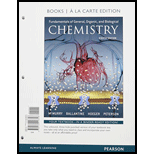
(a)
Interpretation:
The number of covalent bonds and the lone pairs of electron in the molecule formed by reaction between given atoms is to be drawn by using electron-dot symbols with lines showing as covalent bonds.
Concept introduction:
Covalent bonds are formed by sharing of electrons between atoms.
The valence electrons of Aluminum are 3 electrons.
The valence electrons of Bromine are 7 electrons.
(b)
Interpretation:
The number of covalent bonds and the lone pairs of electron in the molecule formed by reaction between given atoms is to be drawn by using electron-dot symbols.
Concept introduction:
Covalent bonds are formed by sharing of electrons between atoms.
The valence electrons of Carbon are 3 electrons.
The valence electrons of Fluorine are 7 electrons.
(c)
Interpretation:
The number of bonds formed by each atom is the given molecule and the structure of the given molecule using electron-dot symbols.
Concept introduction:
Ionic bonds are formed by complete transfer of electrons from one atom to other atom.
The valence electrons of Cesium are 1 electron.
The valence electrons of Iodine are 7 electron.
(d)
Interpretation:
The number of bonds formed by each atom is the given molecule and the structure of the given molecule using electron-dot symbols.
Concept introduction:
Ionic bonds are formed by complete transfer of electrons from one atom to other atom.
The valence electrons of Zinc are 1 electron.
The valence electrons of Fluorine are 7 electron.
(e)
Interpretation:
The number of bonds formed by each atom is the given molecule and the structure of the given molecule using electron-dot symbols.
Concept introduction:
Ionic bonds are formed by complete transfer of electrons from one atom to other atom.
The valence electrons of Lithium are 1 electron.
The valence electrons of Chlorine are 7 electron.
Want to see the full answer?
Check out a sample textbook solution
Chapter 4 Solutions
Fundamentals of General, Organic, and Biological Chemistry, Books a la Carte Plus Mastering Chemistry with Pearson eText -- Access Card Package (8th Edition)
- Elemental analysis of a compound with molar mass 342.3 g/mol gives the following mass percent composition: C 42.11%, H 6.48%, O 51.41%. Find the molecular formula of the compound. Enter your answer in the space below using the following format: if the molecular formula of a compound containing elements X, Y, and Z is X2YZ3 enter your answer as X2YZ3.arrow_forwardColumn A shows the names of some of the c functional groups. Column B shows their structure. Match each entry in column A one in column B.arrow_forwardDetermine the chemical formula for the following molecules by counting the Carbon, Hydrogen and Oxygen atoms. Determine if the molecule is a carbohydrate by checking the ratio of atoms. 5. Ho C 1 H-C-OH H-C-OH H-C-OH CH₂OH 6. CH₂OH HO-C=0 [ H-C-OH H-C-OH 1 H-C-DH I H - COH I H-C-H I H Chemical formula Carbohydrate ? Chemical formula Carbohydrate ?arrow_forward
- Determine the chemical formula for the following molecules by counting the Carbon, Hydrogen and Oxygen atoms. Determine if the molecule is a carbohydrate by checking the ratio of atoms. 5. Ho C H-C-OH I H-C-OH H-C-OH [ CH₂OH 6. CH₂OH HO-C=O H-C-OH 1 H-C-OH 1 H-C-DH 1 H - COH I H-C-H I H Chemical formula Carbohydrate? Chemical formula Carbohydrate ?arrow_forwardThe oxygen we breathe is a molecule of two oxygen atoms. Use the symbol for oxygen "O" and a subscript to give the correct chemical notation for this molecule.arrow_forwardFor the first part, draw a Fischer projection formula for the enantiomer of each of the following monosaccharides. For the second part, identify whether the images are in D- or L-configuration. Write your answers first on a piece of bond paper.arrow_forward
- Just question 7.52arrow_forwardDimethyl ether has the same molecular formula as ethanol (Problem 4.57) but very different properties. Propose a structure for dimethyl ether in which the oxygen is bonded to two carbonsarrow_forwardWith the given structures, arrange the following compounds in order of decreasing reactivity towards hydrolysisarrow_forward
- Benzene is a carbohydrate ubiquitous to organic chemistry. Its structure was proposed near the end of the 1800s by the, German chemist Kekul'e after he supposedly dreamt of a snake devouring its own tail. Knowing that benzene has a percent composition of 92.24% carbon and 7.76% hydrogen by mass and a molar mass of 78.11 g/mol, determine the compound's molecular formulas. Please provide your answer as the value of n.arrow_forwardIdentify the conjugate acids and bases in the following pairs of substances. (CH3)3NH / (CH3)3N *H3NCH2CH,C00 / H2NCH;CH2COO OOCCH,COOH/ 00CCH2CO0arrow_forwardConsider these compounds: A. PbBr, B. MnS C. Ag,CO3 D. AIPO, Complete the following statements by entering the letter(s) corresponding to the correct compound(s). (If more than one compound fits the description, include all the relevant compounds by writing your answer as a string of characters without punctuation, e.g, ABC.) Without doing any calculations it is possible to determine that magnesium fluoride is more soluble than and magnesium fluoride is less soluble than| It is not possible to determine whether magnesium fluoride is more or less soluble than by simply comparing Kgp values.arrow_forward
 BiochemistryBiochemistryISBN:9781319114671Author:Lubert Stryer, Jeremy M. Berg, John L. Tymoczko, Gregory J. Gatto Jr.Publisher:W. H. Freeman
BiochemistryBiochemistryISBN:9781319114671Author:Lubert Stryer, Jeremy M. Berg, John L. Tymoczko, Gregory J. Gatto Jr.Publisher:W. H. Freeman Lehninger Principles of BiochemistryBiochemistryISBN:9781464126116Author:David L. Nelson, Michael M. CoxPublisher:W. H. Freeman
Lehninger Principles of BiochemistryBiochemistryISBN:9781464126116Author:David L. Nelson, Michael M. CoxPublisher:W. H. Freeman Fundamentals of Biochemistry: Life at the Molecul...BiochemistryISBN:9781118918401Author:Donald Voet, Judith G. Voet, Charlotte W. PrattPublisher:WILEY
Fundamentals of Biochemistry: Life at the Molecul...BiochemistryISBN:9781118918401Author:Donald Voet, Judith G. Voet, Charlotte W. PrattPublisher:WILEY BiochemistryBiochemistryISBN:9781305961135Author:Mary K. Campbell, Shawn O. Farrell, Owen M. McDougalPublisher:Cengage Learning
BiochemistryBiochemistryISBN:9781305961135Author:Mary K. Campbell, Shawn O. Farrell, Owen M. McDougalPublisher:Cengage Learning BiochemistryBiochemistryISBN:9781305577206Author:Reginald H. Garrett, Charles M. GrishamPublisher:Cengage Learning
BiochemistryBiochemistryISBN:9781305577206Author:Reginald H. Garrett, Charles M. GrishamPublisher:Cengage Learning Fundamentals of General, Organic, and Biological ...BiochemistryISBN:9780134015187Author:John E. McMurry, David S. Ballantine, Carl A. Hoeger, Virginia E. PetersonPublisher:PEARSON
Fundamentals of General, Organic, and Biological ...BiochemistryISBN:9780134015187Author:John E. McMurry, David S. Ballantine, Carl A. Hoeger, Virginia E. PetersonPublisher:PEARSON





